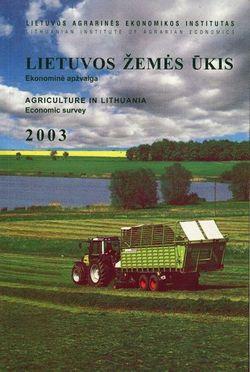
Agriculture performs a significant social, ethno-cultural and environmental function. Rural areas are regarded as the country’s infrastructure determining living standards of both urban and rural population.
More than a half of country’s territory is used for agricultural activities, of which agricultural land makes up 3.37 mill. ha. Land is fertile sufficiently, improved and cultivated. There are favourable conditions to develop dairy and meat farms, cultivate cereals, flax, sugar beet, fruit and vegetables, develop organic farming.
In 2003, rural population made up 33.1% of the total population number, 17.8% were engaged in agricultural activities. The share of agriculture in total value added accounted for 6.1%, and the share in total exports came to 11,7%.
In 2003, 45 thousands of family farms were recorded in the Register. The average size of the family farm was 25.7 ha. There were 579 active agricultural companies and other agricultural enterprises.
At the end of 2003, the ownership rights were restored to 87.5% of the land area indicated in the applications. In the Register of real estate were registered 3.2mill. ha of private land. In many municipalities the process of ownership rights restoration is complete, only in East Lithuania it may last until 2005.
Gross agricultural output over 2003 increased by 2%. Livestock and poultry output grew up by 8% (meat - 13%, milk - 5%, eggs - 0.8%). The purchased amounts of crop and livestock products were larger. Purchase prices of agricultural products were declining, however, farmers’ income accounted for 1.8 bill. Lt and were by 5% larger than in 2002 due to the increase of sales and direct and compensatory payments.
Over 2003, the exports of Lithuanian agricultural and food products grew up by 24%, and, for the first time since 1996, the balance of foreign trade was positive. The exports exceeded net imports by 77 mill. Lt. Dairy products made up the largest share in the structure of exports. The EU was the major Lithuania’s foreign trade partner.
2003 was the last year of the process of preparation to join the united EU market. EU CAP elements (income support, direct payments, intervention purchase system, investment support) were being implemented. The state support to agriculture amounted to 812.2 mill. Lt. SAPARD support for restructuring and modernisation of the agricultural and food sector increased. The National paying agency registered 1055 applications for 909 mill. Lt, agreements concluded accounted for 484 mill. Lt, payments made up 152 mill. Lt.
Stricter requirements for milk, fruit and vegetables quality corresponding EU standards were implemented. A system of cattle and pigs carcasses evaluation, which corresponds to EU requirements, is being implemented. At the end of 2003, 19milk, 15meat, 15 fish, 6 other processing enterprises, 17 vessels, 70 dairy farms conformed to EU veterinary requirements and had licences to export products to the EU market.
Legal acts of the Republic of Lithuania are on the final stage of harmonisation with EU legislation. The being developed integrated administrative and control system guarantees administration of EU funds. Over 13 thousands people were trained by SAPARD funds. In 2003 formation and activity of rural communities were more intensive and at the end of the year there were 365 rural communities.
Economic and social situation in rural areas, meantime, is complicated, unemployment rate is high, and incomes are low. There is a gap between living standards of rural and urban population, deep regional differentiation. After Lithuania becomes EU member, these differences, as shows experience of EU member countries, will decline; the situation in agriculture and in the countryside will improve.
© Quoting requires reference to the source and website address.
